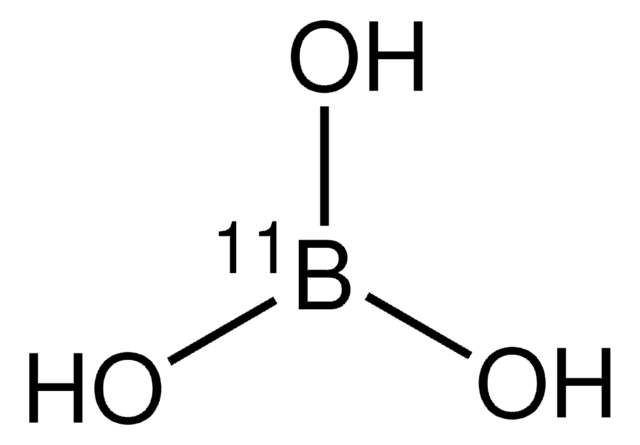202878
Acide borique
99.999% trace metals basis
Synonyme(s) :
orthoboric acid
About This Item
Produits recommandés
Pression de vapeur
2.6 mmHg ( 20 °C)
Niveau de qualité
Essai
99.999% trace metals basis
Forme
crystalline powder
Pf
160 °C (dec.) (lit.)
Solubilité
water: 49.2 g/L at 20 °C
Densité
1.49 g/cm3 at 23 °C
Chaîne SMILES
OB(O)O
InChI
1S/BH3O3/c2-1(3)4/h2-4H
Clé InChI
KGBXLFKZBHKPEV-UHFFFAOYSA-N
Vous recherchez des produits similaires ? Visite Guide de comparaison des produits
Catégories apparentées
Description générale
Application
Boric acid finds uses in several areas; such as
- In glass fibres, to enhance its resistance and color
- In glazing ceramic wares
- As a condensing agent, chemical intermediate and as a precursor for preparation of borates and other boron based compounds
- As a water coolant in nuclear reactors
- In electrolytic condensers and capacitors 1
Conditionnement
Mention d'avertissement
Danger
Mentions de danger
Conseils de prudence
Classification des risques
Repr. 1B
Code de la classe de stockage
6.1C - Combustible acute toxic Cat.3 / toxic compounds or compounds which causing chronic effects
Classe de danger pour l'eau (WGK)
WGK 1
Point d'éclair (°F)
Not applicable
Point d'éclair (°C)
Not applicable
Équipement de protection individuelle
Eyeshields, Gloves, type P3 (EN 143) respirator cartridges
Listes réglementaires
Les listes réglementaires sont principalement fournies pour les produits chimiques. Seules des informations limitées peuvent être fournies ici pour les produits non chimiques. L'absence d'indication signifie qu'aucun des composants n'est répertorié. Il incombe à l'utilisateur de s'assurer de l'utilisation sûre et légale du produit.
EU REACH SVHC Candidate List
EU REACH Annex XVII (Restriction List)
Faites votre choix parmi les versions les plus récentes :
Certificats d'analyse (COA)
Vous ne trouvez pas la bonne version ?
Si vous avez besoin d'une version particulière, vous pouvez rechercher un certificat spécifique par le numéro de lot.
Déjà en possession de ce produit ?
Retrouvez la documentation relative aux produits que vous avez récemment achetés dans la Bibliothèque de documents.
Les clients ont également consulté
Articles
Carbon Molecular sieves (CMS) are a versatile range of adsorbents that can be tailored for specific applications. Supelco® scientists have been synthesizing synthetic CMS carbons for several decades, starting from tailoring of the starting polymers/copolymers, to modifying the final properties of the subsequent CMS carbon.
Global Trade Item Number
| Référence | GTIN |
|---|---|
| 202878-250G | 4061838765321 |
| 202878-10G | 4061838765314 |
| 202878-50G | 4061838765338 |
Notre équipe de scientifiques dispose d'une expérience dans tous les secteurs de la recherche, notamment en sciences de la vie, science des matériaux, synthèse chimique, chromatographie, analyse et dans de nombreux autres domaines..
Contacter notre Service technique



